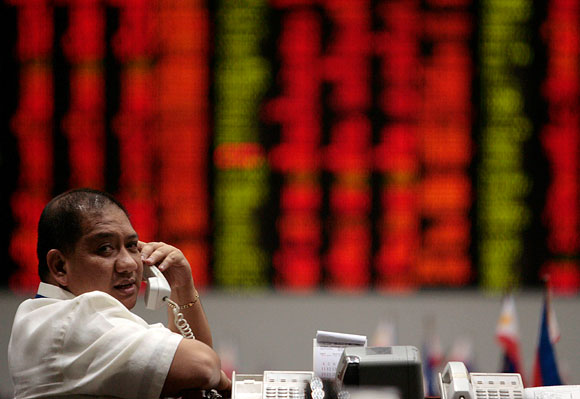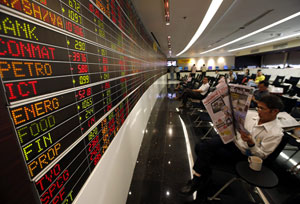Investors should take an in-depth look, rather than jumping head first into Asean
By Gregor Hallmann
Back in May last year, former US Federal Reserve President Ben Bernanke rattled Asian financial markets. Immediately after he started to talk about tightening the ultra-loose monetary policy in the United States, emerging markets’ currencies plunged versus the dollar. The countries most hit across Southeast Asia were Indonesia, the Philippines, Thailand and Malaysia. While most of these currencies recovered slightly towards the end of last year, they still trade well below their pre-May highs.
Bernanke’s so-called ‘tapering’ talk – the new buzzword in financial markets – means the central bank intends to reduce its massive monthly bond buys. In the meantime, the central bank already reduced the amount by $20 billion to $65 billion per month. The buys were initially designed to keep long-term interest rates low in order to stimulate the economy following the financial crisis.

Now, with it looking like the US economy is getting back on track, the Fed may cut back market support step-by-step. Therefore, Bernanke’s tapering comments encouraged market bets on rising interest rates in the US in the foreseeable future.
As a consequence, government bond yields from the US and other developed markets such as the United Kingdom and Germany increased, reducing the yield difference between investments in the developed world and less mature markets such as some in Southeast Asia.
Subsequently, some investors started to withdraw capital out of the Asean bloc, not only due to more attractive yields elsewhere but also because of lower returns on investments. Foreigners’ investment gains sink if they face unfavourable exchange rates and want to repatriate their profits.
“If US yields were much higher, Asean assets have to be cheaper to remain competitive to US bonds or equities,” said Xueming Song, emerging markets fund manager at Deutsche Asset and Wealth Management. So not only did bond investors flee, equities were affected as well.
Worries about the Fed’s tapering might have been the major trigger for the sell-off, yet it would be unfair to blame only Bernanke. Homemade problems contributed as well. The outflow of international capital also revealed imbalances that have been built up in emerging economies during the past, notably high domestic credit growth and deteriorating competitiveness.
The financial and debt crisis forced many developed countries to foster structural reforms and the revitalisation of their economies to restore competitiveness. By contrast, most Asean countries suffered much less and therefore lacked strong reform incentives.
“Comparatively, Asean countries are falling behind as they are not doing enough to keep pace with these big countries,” Song said.
Capital flight and rapid currency devaluations not only affect investors but may also hurt the real economy.
“In the short term, sharp currency movements can result in investors losing confidence as they assume [that] companies may lose capital, like importers of oil do when their currency devalues,” said Peter Sengelmann, a Singapore-based senior portfolio manager for emerging market debt at ING Investment Management.
“Most of the Asean countries need financing for their infrastructure investments and foreign direct investment for their economy – capital outflows do not help,” Song added.
If your home currency is losing value, repercussions are widespread, as importing from abroad becomes more costly.
Indonesia is a case in point. “The sharp depreciation compressed imports and slowed consumer and capital expenditures,” said Desmond Soon, portfolio manager at Legg Mason Western Asset in Singapore. Still, currency devaluations may improve competitiveness, in particular in export-oriented Asean member states.

While the initial financial market reaction following Bernanke’s comments was random selling, in July the market started to distinguish between countries with strong external accounts and those with sizeable current account deficits.
Indonesia’s current account – the sum of the balance of trade and earnings on foreign investments minus payments to investors from abroad and cash transfers – slipped from a surplus only a few years ago to a record deficit in June 2013. Conversely, this example shows that Asean countries should have some buffers to cushion external shocks such as Bernanke’s tapering talk if they tackle homemade problems.
The effects of a currency devaluing also depend on the market structure. “Foreign ownership of local government bond markets is highest in Malaysia and Indonesia,” Soon emphasised. “Outflows should impact the currency and bond markets of these countries the most. However, due to its more developed capital markets, Malaysia has a greater capacity to absorb bond sales from foreigners.“
Indonesia and Thailand are the Asean countries most sensitive to capital run-offs, according to Sengelmann: “Both Indonesia and Thailand are fairly vulnerable. This relates to the openness of their markets, large foreign participation, perceptions about external balances at the sovereign level, economic growth trajectories and other factors such
as politics.”
Malaysia may also be under threat as many foreigners invest in its bond markets and because of its fiscal and balance-of-payment positions. “The countries within Asean that are currently less prone to suffer are the Philippines and Singapore,” Sengelmann added.
For 2014, the billion-dollar questions remain whether capital outflows will continue and where Asean currencies will move to in 2014. “Capital flows are likely to remain a challenge in 2014,” Sengelmann said. “This is not only driven by Fed taper concerns, but also by relative growth dynamics of developed versus emerging markets, coupled with rotations from bonds to equities.
As US yields move higher, investors will demand a greater premium to hold less-liquid Asian local-currency bonds.” However, he expects that this shift is cyclical and capital will again move in favour of Asia.
“The lack of yield opportunities should help Asean inflows resume, and growth rates in Asia should remain significantly higher than in the US, Europe and Japan,” said Rajeev De Mello, head of Asian fixed income at fund company Schroders. “Overall, the Fed will only taper and tighten in response to stronger growth and higher employment, and Asia is a beneficiary of global growth via its competitive manufacturing sector. Stronger growth should be supportive for commodity exporting countries such as Indonesia and Malaysia.”
Meanwhile, Song believes that capital outflows from Asean countries will flatten: “Nobody is expecting the US yields to skyrocket.”
There’s also some hope for Southeast Asia’s foreign exchange rates. “The outlook for Asean currencies is somewhat mixed, but not as negative as one might expect on average,” Sengelmann said. As rates have already adjusted following the first ‘taper tantrum’, he expects that the region’s currencies will not adjust much further once the monetary policy tightening starts in the US.
Still, the rupiah remains overvalued, the baht only slightly so, while the ringgit and the Philippine peso are valued relatively fairly, according to real effective exchange rate statistics from the Bank for International Settlements in Basel. The Vietnamese dong is expected to depreciate gradually.
Slowing economies, which have weak balance-of-payments positions or only small foreign exchange reserve buffers may see greater adjustments.

“Of course, the market reaction will be a function of Fed guidance and the pace of the taper,” emphasises Sengelmann. Moreover, the types of measures taken by other major central banks will prove important, he added. Again it seems as if the fate of Asean currencies lies in the hands of Bernanke, his designated successor Janet Yellen and other central bank kingpins.
Still, the post-May ‘tapering’ phase may have been a wake-up call for policymakers in Asean countries. “They should now take corrective steps to strengthen their economies’ resilience to external shocks,” Soon said.
Some attempts have been made: Indonesia hiked fuel prices, allowed the rupiah to depreciate and strengthened its defence against financial market turbulences.
“We should not forget that Asean countries initiated lots of reforms. Think what the Philippines did in the last few years, what Malaysia just initiated in the fiscal area and what Vietnam is doing at the moment in the financial sector,” Song added.
However, on the closer horizon, Soon expects the rupiah, the ringgit and the baht to remain under pressure given the weak external balances of these countries. By contrast, he expects the Singaporean dollar and the Philippines peso to prove resilient due to their structural current account surplus position. Prospects for Vietnam remain rather mixed.
The dong has been relatively stable due to a steady improvement in the country’s trade account and sharp declines in the inflation rate,” Soon said. “However, challenges remain in economic reforms and dealing with bad debts in the banking system.”
Against this background, investors need to do their homework when investing in Asean currencies and bond markets. “Investors should look very closely if Indonesia initiates reforms after the presidential and parliamentary elections, if Thailand stays politically quiet and at how financial reform in Vietnam is going forward,” Song said. Key factors to watch include the fiscal burden in Malaysia, credit growth and politics in Indonesia and Thailand, as well as the development of trade in the regional bloc, Sengelmann added.
There were times when investments in Asean member states were a no-brainer as the flood of liquidity from developed markets lifted all boats in the region. Those days seem to be over.

